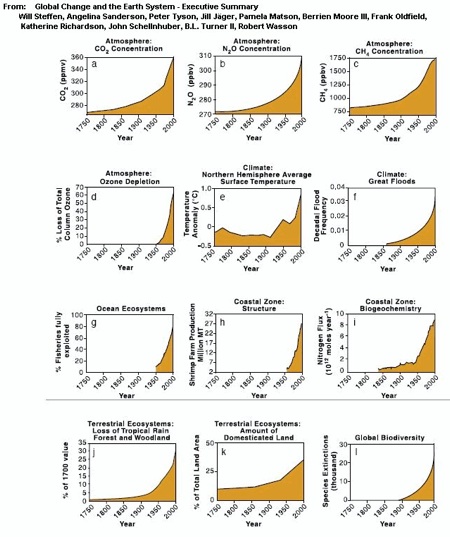Welcome to the Anthropocene
Harvard geochemist Charles Langmuir is an expert on undersea volcanic vents. Looking at the planet as a complex system of moving minerals, changing gases, and blooming life, he sees the geological evolution of Earth as the natural progression that is now being shaped by human activity. In an article in Harvard Gazette he speculates on the future geological stages our planet might go through as human impact increases. Like other recent geologists (see Mineral Evolution) he understands that life is a geological force shaping the landscape and composition of the planet. And like others he believes that humans-plus-technology is becoming a geologic force.
Planets may proceed through a natural series of evolutionary steps that transform them from lifeless balls into the home of bacteria and other microscopic life and then into a place that supports more complex life. Along the way, life interacts with the nonliving parts of the planet in planet-changing ways there’s no guarantee that a planet will proceed from one to the next. Each step represents a moment of both crisis and opportunity.
Some geologists believe human impact on the planet is so strong it warrants viewing this period of time now as the dawn of the Anthropocene — the geological period after the Holocene. The Holocene is defined as the post-glacial geological epoch during the advent of human civilization, the period of time marked by the force of agriculture on the land and atmosphere. But unlike the Holocene, the Anthropocene is marked by the effects of industry, mass consumption, heavy urbanization, and human-led species lost.
In a paper published in GSA Today in February 2008 called “Are we now living in the Anthropocene” a team of geologists put it precise scientific terms:
Since the start of the Industrial Revolution, Earth has endured changes sufficient to leave a global stratigraphic signature distinct from that of the Holocene or of previous Pleistocene interglacial phases, encompassing novel biotic, sedimentary, and geochemical change. These changes, although likely only in their initial phases, are sufficiently distinct and robustly established for suggestions of a Holocene–Anthropocene boundary in the recent historical past to be geologically reasonable.
According to Nobelist Paul Crutzen, who coined the term Anthropocene, a reasonable metric to mark the dawn of this epoch is by the current elevation of CO2. The problem with that is of course that it has elevated for other reasons in the past so it is not a singular metric. Two other potential metrics are changes in the ratio of carbon isotopes due to increased anthropogenic carbon, and the global spread of radioactive isotopes from atom bomb testing.
To assign a more specific date to the onset of the “anthropocene” seems somewhat arbitrary, but we propose the latter part of the 18th century, although we are aware that alternative proposals can be made (some may even want to include the entire holocene). However, we choose this date because, during the past two centuries, the global effects of human activities have become clearly noticeable. This is the period when data retrieved from glacial ice cores show the beginning of a growth in the atmospheric concentrations of several ‘greenhouse gases”, in particular C02 and CH4. Such a starting date also coincides with James Watt’s invention of the steam engine in 1784. About at that time, biotic assemblages in most lakes began to show large changes.

The levels that characterize the start of the Holocene 10,000 years ago have been relatively level for the past 5,000 years, but now (as the chart above shows), in the last few hundred years a new set of risinging levels have appeared.
Scientists are just now starting to catalog the planetary scale changes due to the technium. As a starter list of Anthropocene effects Crutzen suggests these:
30-50% of the land surface has been transformed by human action; more nitrogen is now fixed synthetically and applied as fertilizers in agriculture than fixed naturally in all terrestrial ecosystems; the escape into the atmosphere of NO from fossil fuel and biomass combustion likewise is larger than the natural inputs, giving rise to photochemical ozone (‘smog’) formation in extensive regions of the world.
A close up view of the Anthropocene may be seen in this mosaic of graphs below from Global Change and the Earth System (PDF). (Individually the graphs should be accepted with caution since some are based on actual data and others on computer models.) But they do give a sense of the general scale of change on global attributes.

The common fear stemming from snapshots like these is that the next stage of planetary development may derailed in the Anthropocene. As Langmuir writes:
Human degradation of the environment has the potential to stall an ongoing process of planetary evolution, and even rewind the evolutionary clock to leave the planet habitable only by the bacteria that dominated billions of years of Earth’s history. The Earth today may be at the brink of another step. Complex life has evolved into intelligent life that dominates the planet — ecosystems, food webs, and energy flow — as no species ever has before. Whether the planet takes the next step or not may depend on us.
Crutzen puts the challenge well:
…Mankind will remain a major geological force for many millennia, maybe millions of years, to come. To develop a world-wide accepted strategy leading to sustainability of ecosystems against human induced stresses will be one of the great future tasks of mankind, requiring intensive research efforts and wise application of the knowledge thus acquired in the noösphere, better known as knowledge or information society.
Technology is shaping not just our lives, but also our world. If the technium continues to expand it will become the largest geological force at work on the geosphere, atmosphere and biosphere combined. It is becoming not just a human force, not just a civilizational force, but a planetary force.


